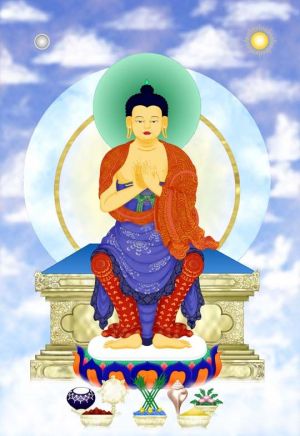God and Amida Buddha
The most important thing for us to understand Buddhism is the fact that Shakyamuni, a human being, awakened to truth and became the Buddha. We discussed the three-bodies of Buddha (trikaya) previously. This was an expression of the insight of Shakyamuni's enlightenment. The fact that Shakyamuni became a buddha means that every human being can become a buddha. The Mahayana tradition strongly emphasizes that every sentient being has
buddha-nature (Skt. buddhata, Jp. bussho). We have buddha-nature within ourselves. A buddha and an ordinary person are ultimately the same by nature, the same ontologically. The only difference is the degree of apprehension of truth. A buddha has attained perfect wisdom, but we sentient beings have not yet attained it. That is, a buddha and an ordinary person differ from each other epistemologically.
On the other hand the Christian God has a different nature from Buddha. God is the creator of the universe, the absolute existence, the highest being, etc. God is quite different from man. He is the creator and man is the created. God is perfect good and man is a sinner. Man cannot become God however hard he may try. God and man are totally different from each other by nature, different ontologically. While God is perfect truth, man
cannot attain the perfect truth of God. God is far from us. He is beyond our apprehension. God and man differ from each other epistemologically. Thus the difference between God and Buddha in relation to man would be as follows: God is different from man epistemologically and ontologically, whereas Buddha is different from man epistemologically but not ontologically.
However, when we come to Pure Land Buddhism, God and Amida Buddha seem to be the same. Both are believed in as a savior by devotees. Among the branches of Buddhism, the Pure Land school particularly emphasizes "faith." Devotees of the school realize that they do not attain enlightenment by their own power, but by simply having faith in Amida's power of salvation.
We have buddha-nature within ourselves but we cannot reveal its true nature by ourselves. Its revelation is achieved only by Amida's grace. Our salvation is entirely dependent upon Amida Buddha. Thus as far as this aspect of Amida as a savior is concerned, we may see that Amida and God appear to be the same, but Amida also has a different aspect from that of God. Amida Buddha is not the creator or ground of all being.
According to the Sutra of Immeasurable Life, Amida Buddha is described as follows. Many eons ago there was a king. He had the opportunity to listen to a sermon given by a buddha, Tathagata Lokeshvararaja (Sejizaio-nyorai). Upon hearing the sermon, he made up his mind to renounce his palace life, and he became a monk called Bodhisattva Dharmakara (Hozo-bosatsu). He established forty-eight vows as a Bodhisattva and practiced austere religious disciplines for a long time. He accomplished these vows and became the Buddha called Amitabha. Among the forty-eight vows, the eighteenth vow is the vow of the nembutsu through which every man can attain salvation.
Now you may notice that Amida was a man and became a buddha. He is not the creator nor an absolute being, but his prolonged religious practices made him a great savior of the world. This indicates that he does not belong to the domain of God but to that of Buddha. He is within the range of Buddhist divinity Furthermore, the story of Amida's enlightenment reflects the life of Shakyamuni. This means that Amida Buddha is the symbolic expression of the ultimate nature of Shakyamuni Buddha. He is the great liberator of the world and the great source of all life. Once again, God and Amida Buddha are both considered great saviors of the world.
From A Raft from The Other Shore Honen and the Way of Pure Land Buddhism by Sho-on Hattori, published by Jodo Shu Press and available at amazon.com
Source
[[1]]
